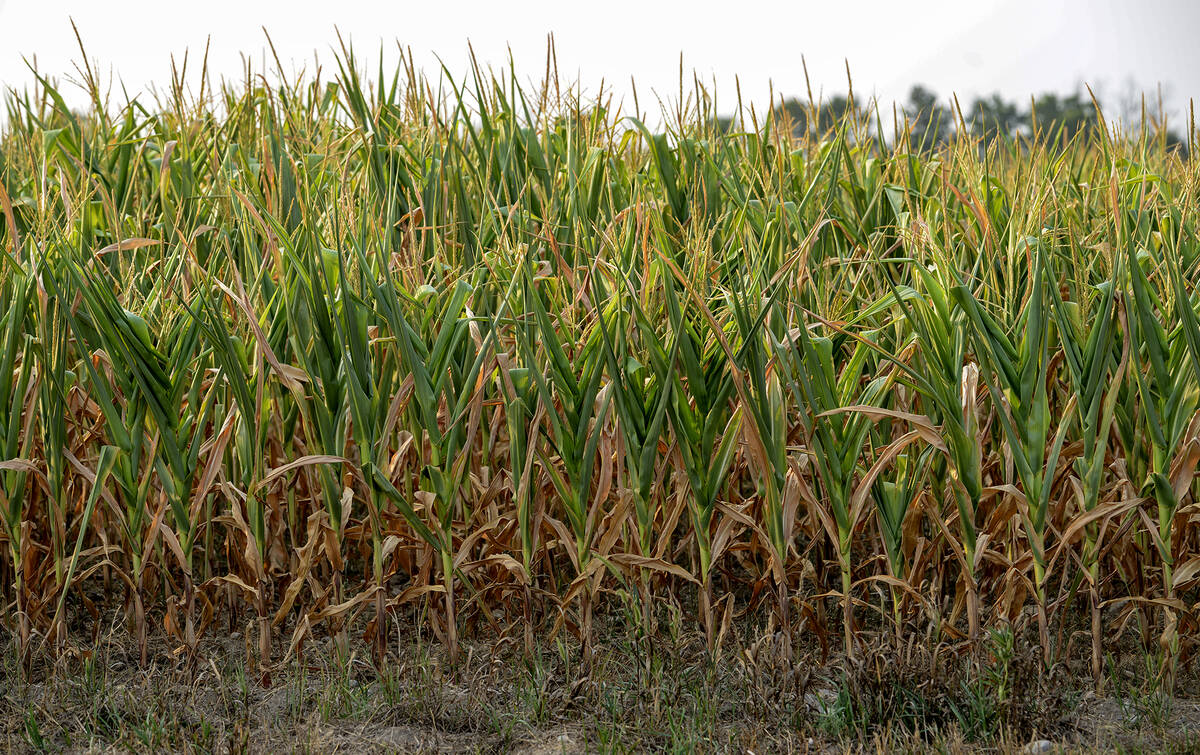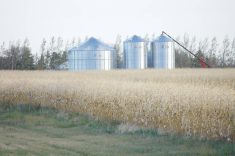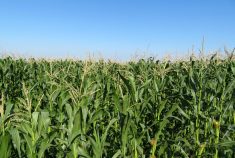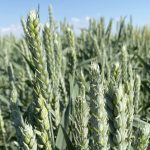The average temperature in Ontario during August was two to three degrees Celsius below normal while most of the growing region experienced average precipitation.
The corn and soybean crops need warm weather to advance crop development. Most of the Ontario growing region has an average frost date between Oct. 1 and Oct. 10; areas closer to the lakes have an average frost date of Oct. 11 to 20. Most of the soybeans will be harvested in mid to late October while the corn will come off during the last half of October or early November.
Read Also

Extreme variability marks Ontario’s 2025 corn crop
The yield potential of Ontario’s 2025 corn crop was lost in some areas due to extreme dry conditions.
There is a high risk that the corn and soybean crops will not make maturity with the trend in weather reflecting below normal temperatures.
Quick look
Soybeans: Soybean yield is expected to be down almost 10 bushels per acre this year over last.
Corn: Ontario corn is trading at a premium to U.S. and South American corn.
Wheat: Wheat usually rallies after the North American harvest is complete. Watch for that this year.
According to Statistics Canada, Ontario corn and soybean yields will come in below year-ago levels. Despite the year-over-year decline in production, grain and oilseed prices continue to grind lower due to softer export and domestic demand.
U.S. soybeans are providing stiff competition to non-Chinese destinations; South American corn continues to trade at a discount to U.S. and Ontario origin stifling offshore movement. Ethanol margins have come under pressure limiting domestic demand while cattle on feed inventories are at seasonal lows. Domestic soybean crush margins are suffering with soymeal futures near contract lows.
U.S. and Chinese trade talks are expected to resume in October; however, we don’t expect any major breakthroughs. The Canadian dollar appears to be strengthening and contributing to price weakness. Exports of crude oil have increased making the Canadian dollar more correlation with the energy market. Secondly, the U.S. Federal Reserve is expected to lower its lending rate on Sept. 18 while the Bank of Canada is expected to keep rates unchanged until the first quarter of 2020. The narrowing of the U.S. interest rate premium over Canadian lending rates is supportive for the Canadian dollar.
Soybeans
Statistics Canada’s July crop survey had the average Ontario soybean yield at 43.6 bushels per acre resulting in production of 3.7 million tonnes. This compares to last year’s production of 4.2 million tonnes coming from a yield of 51.4 bushels per acre. The Ontario market is in a very unique situation. Old crop stocks are relatively snug because of the larger export program earlier in the 2018/19 crop year. This tight stock situation comes at a time when the upcoming crop is three weeks behind normal development. Therefore, Western Canadian soybeans are cheapest in the world and continue to trade into Ontario.
Brazilian soybeans are trading into China at a US$37/ tonnes premium to U.S. soybeans off the West Coast and a US$25/ tonnes to U.S. soybeans out of the Gulf. Logistical delays have cleared up along the Mississippi and we’re seeing very aggressive offers out of the Gulf for Europe and non-Chinese destinations. While Ontario stocks are tight, the U.S. is contending with a record large carryout from 2019/20. U.S. farmers have been aggressive sellers late in the crop year now that they have a better idea of their subsidy due to the Chinese tariffs on U.S. soybeans.
What to do: We were aggressive with old crop sales last fall and we’ve advised producers to be 30 per cent to 40 per cent sold on their 2019 production. There are rumors that China will extend an olive branch to the U.S. and buy some soybeans in November through January as they’ll need some U.S. beans to hold them over until Argentine and Brazil new crop soybeans are available. This will provide a minor rally in late fall or early winter. This rally could be further enhanced if Brazil or Argentina experiences dryer conditions during the growing season. Producers following our advice are in good shape because you don’t want to sell too much before the crop yield and quality is more certain.
Corn
Ontario corn yields are expected to average 156.1 bushels per acre according to Statistics Canada, down from the 2018 yield of 166.0 bushels per acre. Using this yield, the 2019 corn production has potential to finish near 8.6 million tonnes, down from 2018 crop size of 8.8 million tonnes.
The Ontario corn market is trading at a premium to U.S. and South American corn due to the uncertainty in production and tight old crop stocks. For the week ending Sept. 2, year-to-date Canadian corn exports were 12,500 tonnes, down from 124,800 tonnes last year. We don’t expect the Ontario export pace to increase until late November or December. When Ontario supplies are available after harvest, prices will have to be lower to compete with other major exporters. Buying interest from local ethanol producers has deteriorated due to the negative margin structure. Ontario cattle on feed inventories are at seasonal lows contributing to the softer domestic demand.
The U.S. corn crop also needs favorable weather over the next month; therefore, we may see the futures market incorporate a small risk premium until the U.S. harvest is underway. This small rally will be a selling opportunity because world supplies are still burdensome and U.S. domestic demand remains very soft.
What to do: Earlier in summer, we advised producers to sell 30 per cent of their expected new crop production. This sales level is conducive to match the risk with quality and yields. Once the Ontario harvest is completed, we’ll increase our sales recommendation. Looking forward, we may see lower South American corn production as the market is encouraging soybean plantings. Export demand for Ontario corn may improve if South America has a crop problem. Next spring, the U.S. farmer will increase corn acres so we’ll want to have most of the crop sold before the March seeding intentions.
Wheat
There was an old commodity trader that had four sons. When he died, the sons thought they were going to inherit his fortune; however, all he left them was his trading rules. In his will, he stated if they followed his rules, they would make a fortune like him. The book is called “Voice from the Tomb”; an old commodity trader favorite.
One of the rules was to buy wheat futures on Yom Kippur and sell on U.S. Thanksgiving. There is a very strong seasonal tendency for the wheat market to rally after the Northern Hemisphere wheat harvest is completed.
The average Ontario winter wheat yield was estimated at 79.3 bushels per acre resulting in production of 1.4 million tonnes. This compares to last year’s yield of 83.6 bushels per acre and a crop size of 2.1 million tonnes. We’ve seen active movement through the lakes system into Quebec for domestic usage and export movement. U.S. buyers have also been shopping due to year-over-year decline in U.S. production.
Milling wheat supplies in Canada are expected to be very tight for the 2019/20 crop year. The Western Canadian harvest was estimated at 25 per cent complete as of Sept. 9. Adverse rains are in the forecast for much of prairies which will downgrade the wheat crop. Protein is expected to come in below average. There is going to be a fair amount of feed wheat in Western Canada this year.
What to do: We advised producers to sell 30 per cent of the winter wheat production during the harvest period. Producers with feed wheat were advised to sell all their production immediately due to the burdensome feed grain situation. The current weather forecast confirms this decision. Our next sales recommendation will likely come in late October or early November. We’ll be listening to the “voice from the tomb” for the timing of our next sale.













